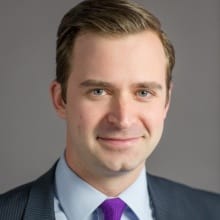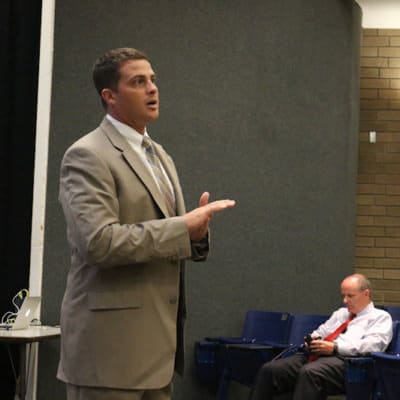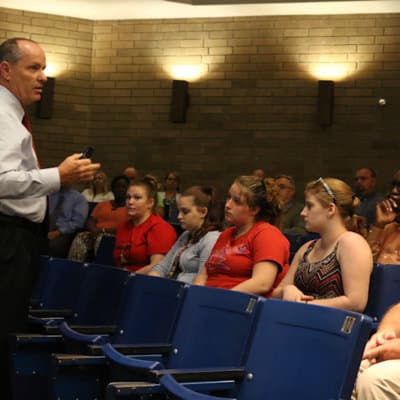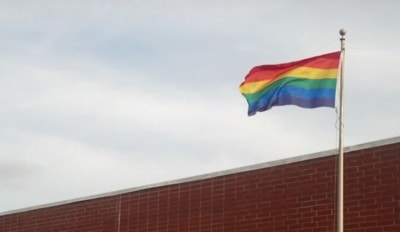Editor’s Note: This is the second in a five-part series examining youth suicide in North Carolina. Scenes in this series may be disturbing to some readers. If you need help, call the National Suicide Prevention Lifeline at 1-800-273-8255.
Kelly Lister’s job title has changed, but her mission is the same:
Keeping Wake County public school students and employees safe.
Lister joined the state’s largest school system in 1994 as a social worker, and in 2007, after working on a campus for 13 years, she was named the district’s crisis intervention specialist. A large part of her job is leading WCPSS programs designed to prevent and respond to suicide, what Lister calls “prevention to postvention.”
“I do feel like it is a community effort to keep kids safe,” she says.
Lister directs comprehensive training programs for student services staff — nurses, counselors, social workers, and psychologists — who are based in every school. When those employees are hired, they attend a mandatory, day-long suicide prevention training where they are taught to recognize the risk factors and warning signs of a student in crisis. The student services teams come back every two years for a refresher course. “We keep it in the very forefront of their training expectations,” Lister says.
Additionally, every WCPSS employee who interacts with students — from teachers to custodians — has to attend a suicide awareness training session at the beginning of each school year. “Any adult who has any interaction with students needs to know the risk factors and what to do to get a child help,” she says. “You’ve got cafeteria workers who see those kids every day and they can overhear all sorts of things.”
Students in Wake County schools learn about suicide in seventh, ninth, and twelfth grades through a program called “Signs of Suicide” that discusses risk factors and warning signs. At the end of the training session, students take a screening assessment and have the opportunity to request an assessment from a nurse, counselor, psychologist, or social worker — a member of the team with specialized training.
Any student who requests an assessment will receive one by the end of that school day.
Lister has briefed members of the state’s Child Fatality Task Force, and its members hold Wake County’s suicide prevention program up as a model for other school districts in the state.
But it is far from the norm in North Carolina.
“We have good programs,” says Michelle Hughes, who runs NC Child, an advocacy group that works on children’s issues. “What we don’t always have is the resources to make sure they are available equally across the state. So you see pockets of programs and resources.”
Hughes serves on the Child Fatality Task Force and is working with a coalition of public- and private-sector experts to develop a few key policy recommendations designed to prevent suicide, particularly among children and young adults.
“This is something that is completely preventable.”
The task force will begin to outline some of those recommendations this week, and will finalize their list of priorities — to be presented to the governor and General Assembly — before the end of the year. But members are beginning to focus on two things: increasing the availability of training programs like the ones Lister runs in Wake County, and increasing the student services staff who implement them.
According to the latest numbers presented to the task force, North Carolina has a little more than 4,000 school counselors, an average of one for every 386 students. The nationally recommended ratio is one counselor for every 250 students.
North Carolina has one school social worker for every 1,606 students; the national recommendation is one per every 750. The largest disparity is in school psychologists. The state ratio is one to 2,056 students, while the national recommendation is one for every 750 students.
Just 45 of the state’s 115 public school districts have school nurses at or above the nationally-recommended ratio of one for every 750 students. The statewide average is one to every 1,112 students, but some districts’ ratios are twice that high.
“I think our task force members were surprised to hear that data,” says Kella Hatcher, the group’s executive director.
North Carolina would need to hire nearly 800 additional school nurses over the next five years to get all school districts at or above the nationally-recommended ratios. Hiring nurses is expensive — tens of millions of dollars, state lawmakers say — and it’s tough to prove how many suicides are prevented because a nurse was able to intervene. Nonetheless, it’s money worth spending, Hughes says. The task force plans to endorse a call for more student services personnel before the start of next year’s session.
“That has not gone anywhere yet, but it’s something folks are looking at,” she says. “I believe that policymakers want what’s best for young people and the number of suicides has absolutely caught their attention.”
The medical community is paying attention, too.
A report from the American Academy of Pediatrics released earlier this year said suicide is the second leading cause of death for 15- to 19-year-olds in America. The journal Pediatrics published the article, which encourages primary care providers to talk to children about mental health issues during routine physicals. “Primary care pediatricians should be comfortable screening patients for suicide, mood disorders, and substance abuse and dependence,” the report said.
And then there are student-led programs, such as one Pender County School launched this year.
The HOPE Squad is a group of students who receive specialized training about suicide prevention. They watch for warning signs and monitor at-risk peers, and will report concerns to an adult. The district is training students now, and the program should be up and running later this month.
“We are often scared to start the conversation about suicide because we are worried that by talking about it, we may give someone the idea to self harm,” said Pender High School Principal Chris Madden at a meeting to roll out the program back in August. “But our students are already talking about it. By starting a community dialogue and developing an understanding of the warning signs, we can save lives.”
Back in Raleigh, Lister says anyone who interacts with a child — not just doctors, students, and peers — should be watching for warning signs of suicide. “If they suspect or hear anything that is concerning for a child’s safety, they need to pass that information on to folks who have been trained to look a little deeper,” she says.
“We need to be a team. All of us.”
Coming tomorrow: What you need to know about the warning signs for suicide.





